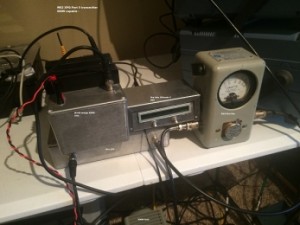 From ARVic, original post here.
From ARVic, original post here.
The Weak Signal Propagation Reporter or WSPR mode has achieved the first VK3-KL7, 475 kHz contact – a distance of more than 12,000 kilometres. Phil Dwyer VK3ELV of Mount Bruno in northwest Victoria Australia on Tuesday (February 9) had an opening with Laurence Howell KL7L, who uses the FCC experimental callsign WE2XPQ, in Wasilla, south west central Alaska.
Laurence KL7L says 600m Transpacific conditions were good at the time with openings from VK-JA and KH6-JA-VK. But given the K indices had rises abruptly to 5 in Alaska, which Laurence says normally sucks the life out of the ionosphere, he was surprised to see the VK3ELV callsign appear on screen.
There was also a 137 kHz opening from KL7 to JA with multiple WSPR 15 decodes at JA5FP from WE2XPQ. Laurence used a Eprobe and Icom R75 to receive, using Joe Taylor’s WSJT-X software to decode – fed by a small one metre long receive antennae 10 metres up a Birch tree in the lee of the Talkeetna mountains on a glacial plain.
To gain the distance Phil VK3ELV has made a few improvements to his antenna system and now runs close to the 5 watts EIRP. This varies a bit depending on the soil moisture (conductivity) from day to day. He says exploring propagation quite regular, VK3ELV and Berndt Wulf VK5ABN reports now come from Japan, and also regularly WH2XCR in Hawaii.
Phil says: “An added bonus is WH2XCR in now also transmitting about 1 Watt EIRP and regularly received on the VK2 coast by John Simon VK2XGJ and also at VK3ELV, that makes a 2-way path from VK3 to Hawaii. “It was a surprise to receive a report from Alaska at 12,333 km. This may be very surprising to some, it may a first from VK3 to KL7, but it is no distance record.
“Dale Hughes VK1DSH had his signal spotted once in France in 2013. Last Spring both Canadian and main land US stations were received in VK5, VK7, VK3 and VK2. If someone was listening on the north-west coast of VK6, I’m sure they will receive European stations.”
The new frontier of 472-479 kHz is being explored by radio amateurs who were granted a secondary allocation at the World Radiocommunication Conference in 2012.
